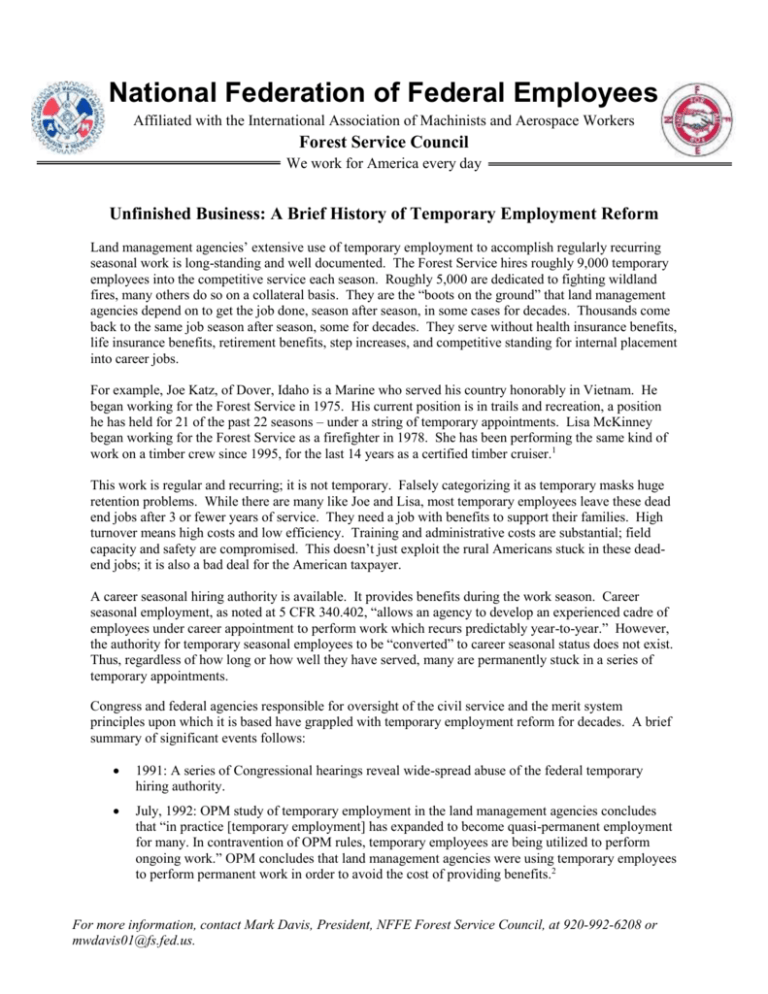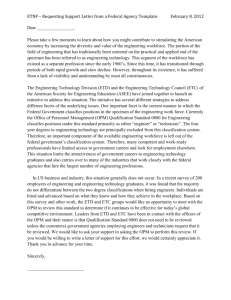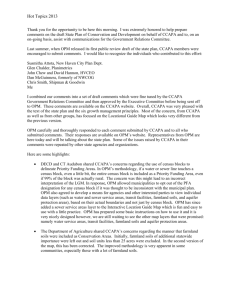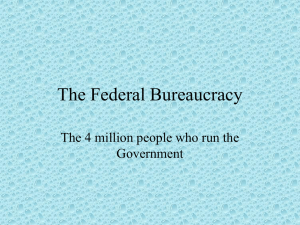Unfinished Business: A Brief History of
advertisement

National Federation of Federal Employees Affiliated with the International Association of Machinists and Aerospace Workers Forest Service Council We work for America every day Unfinished Business: A Brief History of Temporary Employment Reform Land management agencies’ extensive use of temporary employment to accomplish regularly recurring seasonal work is long-standing and well documented. The Forest Service hires roughly 9,000 temporary employees into the competitive service each season. Roughly 5,000 are dedicated to fighting wildland fires, many others do so on a collateral basis. They are the “boots on the ground” that land management agencies depend on to get the job done, season after season, in some cases for decades. Thousands come back to the same job season after season, some for decades. They serve without health insurance benefits, life insurance benefits, retirement benefits, step increases, and competitive standing for internal placement into career jobs. For example, Joe Katz, of Dover, Idaho is a Marine who served his country honorably in Vietnam. He began working for the Forest Service in 1975. His current position is in trails and recreation, a position he has held for 21 of the past 22 seasons – under a string of temporary appointments. Lisa McKinney began working for the Forest Service as a firefighter in 1978. She has been performing the same kind of work on a timber crew since 1995, for the last 14 years as a certified timber cruiser.1 This work is regular and recurring; it is not temporary. Falsely categorizing it as temporary masks huge retention problems. While there are many like Joe and Lisa, most temporary employees leave these dead end jobs after 3 or fewer years of service. They need a job with benefits to support their families. High turnover means high costs and low efficiency. Training and administrative costs are substantial; field capacity and safety are compromised. This doesn’t just exploit the rural Americans stuck in these deadend jobs; it is also a bad deal for the American taxpayer. A career seasonal hiring authority is available. It provides benefits during the work season. Career seasonal employment, as noted at 5 CFR 340.402, “allows an agency to develop an experienced cadre of employees under career appointment to perform work which recurs predictably year-to-year.” However, the authority for temporary seasonal employees to be “converted” to career seasonal status does not exist. Thus, regardless of how long or how well they have served, many are permanently stuck in a series of temporary appointments. Congress and federal agencies responsible for oversight of the civil service and the merit system principles upon which it is based have grappled with temporary employment reform for decades. A brief summary of significant events follows: 1991: A series of Congressional hearings reveal wide-spread abuse of the federal temporary hiring authority. July, 1992: OPM study of temporary employment in the land management agencies concludes that “in practice [temporary employment] has expanded to become quasi-permanent employment for many. In contravention of OPM rules, temporary employees are being utilized to perform ongoing work.” OPM concludes that land management agencies were using temporary employees to perform permanent work in order to avoid the cost of providing benefits.2 For more information, contact Mark Davis, President, NFFE Forest Service Council, at 920-992-6208 or mwdavis01@fs.fed.us. June 23, 1993: At hearing, House Civil Service Subcommittee Chair Frank McCloskey observes, “The blatant abuse of temporary employees in Federal agencies is one of the most disturbing occurrences I have encountered during my time in Government… OPM regulations leave endless possibilities for the manipulation of temporary workers. Agencies can easily circumvent OPM's regulations… The fact that a temporary worker has been employed for 20 years without any rights is heinous and must not be allowed to continue… There is a dire need for reform.” 3 July 5, 1993: James Hudson dies after working three eight-hour shifts over two days. Mr. Hudson, a decorated Vietnam veteran, was a National Park Service employee who supervised other Parks employees and cared for the Lincoln Memorial. An eight-year employee, he was classified as “temporary,” and thus ineligible for benefits granted permanent workers. His widow and seven children receive nothing upon his death. Subsequently, Congress approves a payment of $38,400, the amount his widow would have received had Mr. Hudson been able to obtain the life insurance benefit offered to permanent employees.4 July 15, 1993: James Hudson Temporary Employee Equity Act of 1993 is introduced, under which federal “long-term temporary” employees would be eligible for the same health insurance, life insurance, and retirement benefits as their permanent coworkers. James Hudson’s widow observes, “"Something good has come out of the death of my husband. This legislation means no one else will have to go through what this family went through last week."5 The bill subsequently dies in Committee. July 6, 1994: Fourteen federal firefighters are killed in the line of duty, battling the Storm King (also called South Canyon) fire in Colorado. Twelve were temporary employees, ineligible for the health insurance, life insurance, and retirement benefits provided to permanent employees. September, 1994: MSPB releases a report on temporary federal employment.6 They conclude that “temporary employment policy should be based on the assumption that the employment will normally be on a one-time, short-duration basis. To proceed on any other basis would serve to create a permanent underclass in the federal workforce…” The report discusses proposals and bills that would provide temporary employees with: o retirement and health and life insurance benefits, and o competitive status for transfer, reassignment, or merit promotion procedures, in recognition of the fact that “legal and procedural barriers… often preclude the consideration of many temporary employees for permanent positions regardless of how well they have performed.”7 November 14, 1994: New OPM regulations on temporary employment are implemented. The duration of a temporary appointment is reduced from four to two years, and a requirement that the supervisor must certify that the employment need is truly temporary is added. However, seasonal work of less than six months’ duration is exempted from these requirements, meaning that for seasonal work there is “no limit on the number of extensions or noncompetitive reappointments, as long as the employees [are] paid for less than 1,040 hours each year.” OPM noted that:8 o this reform was “an interim measure… pending more comprehensive reform,” o they supported the National Performance Review (NPR) recommendations to provide benefits, within-grade increases, and standing to compete under merit promotion procedures to temporary employees, but lacked the authority to implement them by regulation, and For more information, contact Mark Davis, President, NFFE Forest Service Council, at 920-992-6208 or mwdavis01@fs.fed.us. o they expected legislation to be proposed based on NPR recommendations within a few months (which never materialized). March, 2002: The General Accounting Office (GAO) releases a report on temporary federal employment.9 GAO concludes, “OPM stated that its intention in revising the regulations was to help ensure that temporary limited employees would be used to meet truly short-term needs and not serve for years without many of the benefits afforded other long-term employees. However, the regulations do not preclude agencies from hiring temporary limited employees to work in a series of extensions, reappointments, and appointments. Thus, there seems to be an inconsistency between OPM’s stated intent and what is permissible under the provisions of its regulations. The regulations allow agencies to continue a pattern of repetitive temporary appointments that result in long-term temporary limited employees not receiving many of the benefits available to other long-term employees.” Among the findings are: o neither OPM nor any of the agencies studied (accounting for 92% of federal temporary hires) had monitored the total years of temporary employment by individuals, and o In 2000, 60% of the 16,232 temporary employees hired who had 5 years or more of service,10 and 67% of the 8,873 who had 10 years or more of service, were hired into temporary seasonal/intermittent positions. Notes See “Permanent Fix,” Elizabeth Newell, Government Executive, August 1, 2010 (http://www.govexec.com/features/0810-01/0810-01na1.htm) and Statement of William R. Dougan, President of the National Federation of Federal Employees, before the House Subcommittee on the Federal Workforce, Postal Service, and the District of Columbia regarding Temporary Employment Practices (June 30, 2010) (http://www.nffe-fsc.org/committees/legislative/100630_Statement_Temp_Reform.pdf). 1 OPM’s conclusions are cited in MSPB, “Temporary Federal Employment: In Search of Flexibility and Fairness,” (Sept. 1994) at 23 (http://www.nffe-fsc.org/committees/legislative/temps/MSPB_9409_TempRpt.pdf). We have been unable to locate the original study, OPM, “Temporary Employment within Land Management Agencies of the Federal Government,” (July, 1992). 2 3 See Hearing before the Subcommittee on the Civil Service, Committee on Post Office and Civil Service, House of Representatives, 103rd Congress, “Use of Temporary Employees in the Federal Government,” (June 22, 1993). (http://www.archive.org/stream/useoftemporaryem00unit/useoftemporaryem00unit_djvu.txt) See The Washington Post, “Lincoln Caretaker's Death Brings House-Passed Benefits” (July 16, 1993). (http://www.nffe-fsc.org/committees/legislative/temps/WashPost_930716.pdf) 4 See “Lincoln Caretaker's Death Brings House-Passed Benefits”, supra note 8, and HR 2643 of the 103rd Congress, “The James Hudson Temporary Employee Equity Act of 1993. (http://www.nffe-fsc.org/committees/legislative/temps/Congress_103_HR_2648.pdf.) 5 6 See “Temporary Federal Employment: In Search of Flexibility and Fairness,” supra note 2. One such example is provided by Forest Service Council (FSC) survey response # 21401: “I am a permanent fulltime employee. When I arrived there was a seasonal employee that had been working here for about 30 years. He has helped me so much and he knows the job here so well. I found out later that he applied for my job and another 7 For more information, contact Mark Davis, President, NFFE Forest Service Council, at 920-992-6208 or mwdavis01@fs.fed.us. job this year but because he is 1039 he cannot compete in the forest service sector [under merit promotion procedures]…” See 59 Federal Register, “Temporary and Excepted Service Employment: Proposed Regulations” (Feb. 1, 1994). (http://frwebgate3.access.gpo.gov/cgi-bin/TEXTgate.cgi?WAISdocID=0890385616+0+1+0&WAISaction=retrieve) See 59 Federal Register 46897, supra note 1, for the final regulations, which did not differ in this regard. In rushing implementation, OPM stated, “In view of Congressional and employee concerns and evidence that under existing limits some employees have, indeed, served for years under a succession of temporary appointments, we believe it is critical to make the revised limits effective as soon as possible.” Ironically, this situation has persisted for 15 years. (http://frwebgate3.access.gpo.gov/cgi-bin/TEXTgate.cgi?WAISdocID=0890385616+2+1+0&WAISaction=retrieve) 8 See GAO, “OPM Data Do Not Identify if Temporary Employees Work for Extended Periods,” (March, 2002). (http://www.gao.gov/new.items/d02296.pdf) 9 10 For a seasonal temp, five years of service generally equates to at least ten seasons of service, since they are limited to less than six months of work per appointment per year. The exception is if the employee is appointed to a second temporary position that is not a “successor” position under the regulations at 5 CFR 316.401, in which case the employee can work the entire year as a temporary employee. This can be done indefinitely under current regulations. For more information, contact Mark Davis, President, NFFE Forest Service Council, at 920-992-6208 or mwdavis01@fs.fed.us.






